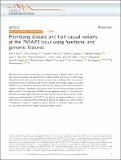| dc.contributor.author | Ray, John P | |
| dc.contributor.author | de Boer, Carl G | |
| dc.contributor.author | Fulco, Charles P | |
| dc.contributor.author | Lareau, Caleb A | |
| dc.contributor.author | Kanai, Masahiro | |
| dc.contributor.author | Ulirsch, Jacob C | |
| dc.contributor.author | Tewhey, Ryan | |
| dc.contributor.author | Ludwig, Leif S | |
| dc.contributor.author | Reilly, Steven K | |
| dc.contributor.author | Bergman, Drew T | |
| dc.contributor.author | Engreitz, Jesse M | |
| dc.contributor.author | Issner, Robbyn | |
| dc.contributor.author | Finucane, Hilary K | |
| dc.contributor.author | Lander, Eric S | |
| dc.contributor.author | Regev, Aviv | |
| dc.contributor.author | Hacohen, Nir | |
| dc.date.accessioned | 2021-10-27T20:34:29Z | |
| dc.date.available | 2021-10-27T20:34:29Z | |
| dc.date.issued | 2020 | |
| dc.identifier.uri | https://hdl.handle.net/1721.1/136246 | |
| dc.description.abstract | Genome-wide association studies have associated thousands of genetic variants with complex traits and diseases, but pinpointing the causal variant(s) among those in tight linkage disequilibrium with each associated variant remains a major challenge. Here, we use seven experimental assays to characterize all common variants at the multiple disease-associated TNFAIP3 locus in five disease-relevant immune cell lines, based on a set of features related to regulatory potential. Trait/disease-associated variants are enriched among SNPs prioritized based on either: (1) residing within CRISPRi-sensitive regulatory regions, or (2) localizing in a chromatin accessible region while displaying allele-specific reporter activity. Of the 15 trait/disease-associated haplotypes at TNFAIP3, 9 have at least one variant meeting one or both of these criteria, 5 of which are further supported by genetic fine-mapping. Our work provides a comprehensive strategy to characterize genetic variation at important disease-associated loci, and aids in the effort to identify trait causal genetic variants. | |
| dc.language.iso | en | |
| dc.publisher | Springer Science and Business Media LLC | |
| dc.relation.isversionof | 10.1038/S41467-020-15022-4 | |
| dc.rights | Creative Commons Attribution 4.0 International license | |
| dc.rights.uri | https://creativecommons.org/licenses/by/4.0/ | |
| dc.source | Nature | |
| dc.title | Prioritizing disease and trait causal variants at the TNFAIP3 locus using functional and genomic features | |
| dc.type | Article | |
| dc.contributor.department | Massachusetts Institute of Technology. Department of Biology | |
| dc.relation.journal | Nature Communications | |
| dc.eprint.version | Final published version | |
| dc.type.uri | http://purl.org/eprint/type/JournalArticle | |
| eprint.status | http://purl.org/eprint/status/PeerReviewed | |
| dc.date.updated | 2021-07-20T17:34:56Z | |
| dspace.orderedauthors | Ray, JP; de Boer, CG; Fulco, CP; Lareau, CA; Kanai, M; Ulirsch, JC; Tewhey, R; Ludwig, LS; Reilly, SK; Bergman, DT; Engreitz, JM; Issner, R; Finucane, HK; Lander, ES; Regev, A; Hacohen, N | |
| dspace.date.submission | 2021-07-20T17:34:58Z | |
| mit.journal.volume | 11 | |
| mit.journal.issue | 1 | |
| mit.license | PUBLISHER_CC | |
| mit.metadata.status | Authority Work and Publication Information Needed | |
